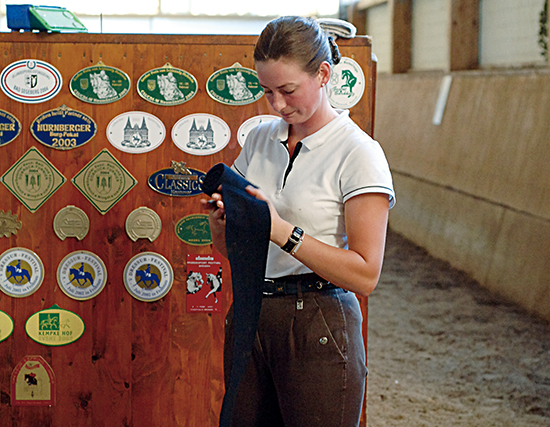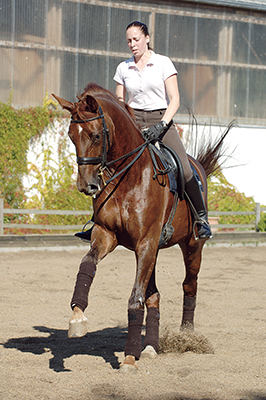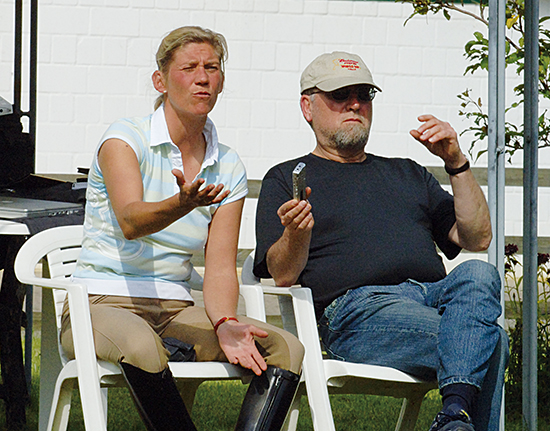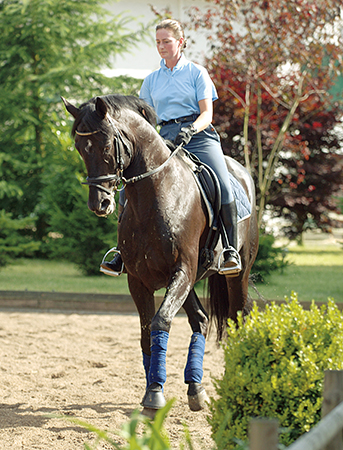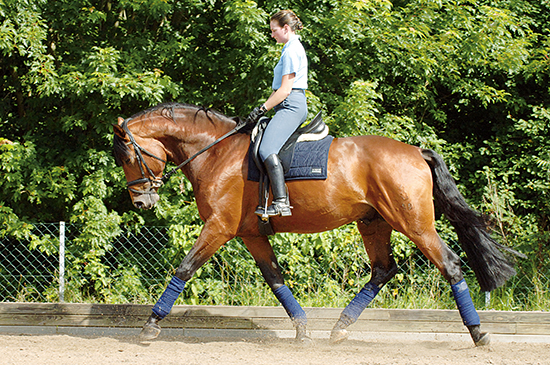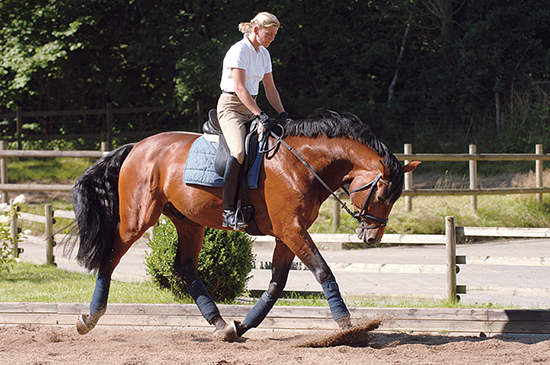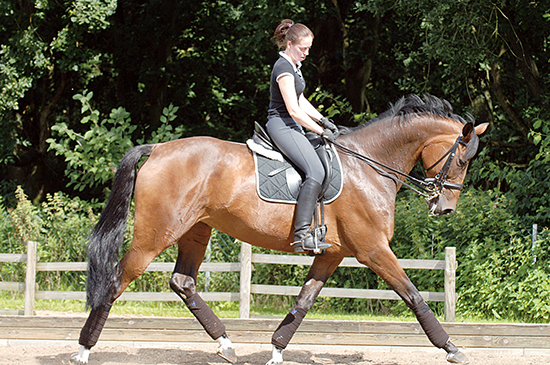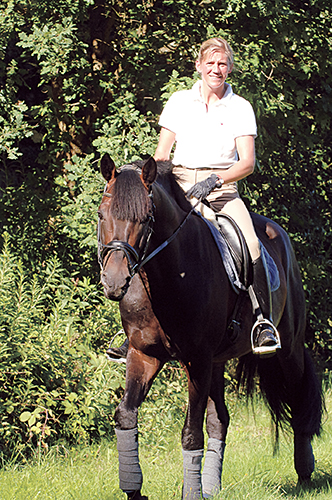 Story by Chris Hector and Photos by Roz Neave
Story by Chris Hector and Photos by Roz Neave
It really is quite amazing the number of stables in Germany you walk into and suddenly hear an Aussie accent, not just at the famous stables, and not just the well known riders – but it seems everywhere you go, there are young Australians with a thirst for knowledge, and the guts to get out and do something about it.
Martina Hannöver is well known in Australia, she has visited several times to conduct clinics, and has hosted a number of young Aussies at her Stal Bollmoor Stables on the outskirts of Hamburg. Boyd Martin was the first to take the plunge (arriving in a minus twenty wintery December), followed by Nick Fyffe. When we last visited, there were two young Australians in residence – Renee Pedretti and Rachael Brennen.
Renee Pedretti
Renee is an old hand at this travelling to Europe caper. It’s the 24 year old’s fifth training trip to Europe.
“The first time, when I was sixteen, I spent one month with Jean Bemelmans, then when I was eighteen I went to Tanya Traupe’s stable in Frankfurt – I went there three times. Last year I had two weeks with Martina and I loved it, it was great, so I came back again for two months.”
“Everything is so simple here. It doesn’t become complicated. There are a lot of trainers who make everything so complicated, Martina makes it simple – it doesn’t mean I can do it still, but I try.”
Rachael Brennen
Twenty three year old Rachael came by a more circuitous route, spending 12 months grooming hunters in Ireland before making it to Germany and Stal Bollmoor.
“I was in Ireland, and my mother got in touch with Martina, and she said it was alright for me to come. Because I’d been in Ireland for a year, grooming, when I came here, I expected to groom for some time first because I was a little bit out of practice. Slowly they put me on more horses, I got my position back a little better, and slowly started riding.”
Martina and her husband, Jorn were pleasantly surprised when their ‘Irish groom’ turned out to be a very elegantly effective dressage rider, but the truth is, Rachael had been competing at the top in her home state of Western Australia for quite some time: “I was on the Western Australian State Young Riders Squad for four years. I have an Advanced horse. Then I worked in Victoria at the Australian Equine Behaviour Centre with Andrew and Manuela McLean. I was there for a year and a half. Then I went back to WA, where I gave lessons and rode horses for people, as well as my own. I have my own small business. My parents have a big dairy farm, and I have my own stables and space to create my own business.”
“Then I decided to go travelling because my horse was not so sound – and before I look for a young horse, I thought I’d better come and learn how to do it better. I’ve been here with Martina for five months, and I plan to stay for one year.”
That’s smart – that way you really get to learn something serious…
“I originally planned to stay for three months. It took me three months to get back into it, and now I have the opportunity to stay for the year, it’s really good. I think after a year, I’ll be a lot more confident with what I’ve learnt. I can practice a lot more here, and when I take it home, hopefully it will be solid.”
Now back in Australia there are all sorts of stories about how hard you have to work, how bad the pressure is, in these German dressage stables, but to tell the truth, both Renee and Rachael seem to smile a lot. Sure the work is hard and the hours are long. Renee’s day starts very early in the morning:
“We start at 6.30 in the morning and finish at about 6 or 7 in the evening, so it is a long day.”
You clean stables?
“We have a man who cleans the stables, we put fresh straw down and sweep and groom, that’s part of the job.”
Rachael positively enjoys the challenge: “I really like it. I think if you want to be here, and you want to learn, there’s no problem. If you come here and expect to start at the top, you have a problem. I came expecting to start at the bottom, I have always worked hard and I knew that if I put the hours in doing the not so good jobs, eventually I’d get to do the better jobs. I think if you wanted to be the best, or be on the best horses, you’d get frustrated and then you would have a problem. I don’t have any problems.”
Martina does yell a bit?
“Sometimes… but she smiles afterwards so it is okay.”
Everyone gets there share of the famous Martina YELL, but according to Renee, sometimes it is justified: “I need to be yelled at sometimes. You are here to learn and if you don’t do what Martina says, then she has to yell at you – and she always smiles at the end of it, it is not as if she is really angry or anything.”
I guess it feels more comfortable now but earlier in the day, Renee was sure getting a hard time of it from Martina.
Renee is really not all that tall, but here she was riding the four year old Avalon, one of the largest horses in the stable! As always, Martina is a stickler for position: “Turn your toe more in so that you come more with the flat leg, and if you want to wake him up, wake him up really, so that you get a reaction, don’t make him tired on your legs.”
Renee and the Sandro Hit stallion, Sir Wilson
Martina has taught Renee before in Australia, and the young rider has been sending her DVDs of her training, so Martina is well aware of the areas that need work: “With Renee’s position, when she works by herself, she sits so her shoulders are a little bit weak and hunched then the tummy goes inside and you have no tension, no strength. Everything comes out of the middle part of the body, so then when you lose the strength from the middle of your body, you try to make up for it with the leg and the spur.”
“The movement should come first out of your weight, then your leg, then your rein – that’s how you have to work. Easy with the rein and the bit, Renee, it is not hard work, do it a little bit slower like a chewing gum, not rub rub, slow so he gets a chance, so the bit is working on the tongue without making the head go left/right/left/right. Flexible in the poll is okay, then active, push into your hand with little half halts, try to get the feeling on the hind legs, so he is not going downhill, he is going more uphill and out of your seat.”
Martina’s lessons can sometimes get a bit like a cross examination session.
“Is he straight? Aha, aha, out of an honest straight horse we can get an honest bending on the inside. Take your reins a little bit shorter and try to put the poll up, and see how long he can handle this, out of your seat, straight, good, yah, keep your hands down, sit into your hands.”
“Circle on the outside rein, try to get him more up and more open, close the horse and then open him again. On the outside rein you keep the control. Come, come, FORWARD! FORWARD!! So.”
That looks fairly tame on the page but those FORWARDs were impressively loud!
“No hurry Renee, let him go, easier, that’s fine, with this big horse, I really want to give him a lot of time.”
Tina turns to me, “Remember him when he was three and he couldn’t carry himself in the canter, and he was not balanced at all – that’s why he needed a little bit longer than the smaller horses.”
“Good, now a little canter. Quiet your legs. See it is a little different working in the outside arena, there is no wall. It is very good especially for the younger riders to be outside, it teaches the riders not to help the horse all the time find balance, the horse should find its own balance without the help of the rider on the reins.”
“When you go straight you sit straight into both hands, inside shoulder back, go whole arena, and go straight out of the whole of your seat bones into your hand. Good, very nice and straight and not so wide from behind.”
“Now give him the rein, a little bit longer, make him stretch and follow your hand on the circle, just to check that he goes down right in front of the saddle – there the neck needs to go down, that’s what I wanted to see, that he is listening to your seat and not just to your reins.”
“Now canter. Take the reins a little shorter and try to keep this big uphill front leg, do it without disturbing him, ask for more uphill out of your seat. Forward, but not working with your upper body, quiet with your upper body, uphill. Now he starts to sweat from behind and everything is working, every single muscle of the body is starting to work – he was a bit tense when he first came out.”
But watch out, praise is likely to be followed by yet another verbal barrage!
“Is he straight? Why do I have to ask this question three times??? Renee can you remember the first thing? Straight and forward.”
“Now I ride the horse.”
And so ends one working session for Renee, for the day.
Time for Rachael and Trakehner mare, Alpina.
According to Martina: ‘She’s 9 years old, I’ve had her for about eight months. She was ridden by an amateur – she won at Medium and is placed in Prix St Georges. She is starting to do a little bit of piaffe and a little bit of passage, but it still doesn’t all fit together but she is trying hard.”
“I think she has a very good hindleg but she is still not able to carry it as good as she should, for this reason she is sometimes not all that good in the mouth. When you put the hind leg more and more to work, then she gets a little bit strong in the hand and you have to get her through and soft again. But she is coming along really nicely.”
And so it would seem, has the young West Australian rider: “Rachael has been here nearly five months. She came from Ireland and started as a groom. She went with me to some top competitions and I let her warm up some horses, and I saw that she really got a lot when she watched me. She is a very good concentrated rider. She has an excellent upper body position, also she’s good with her hands, she is trying hard with her leg to stay more quiet. But that is something we still have to work on. She is just warming up the horse for me then I will work her.”
“Rachael, ride her just on the snaffle and do it slow, long your legs, knees a little bit more back – yeah. Especially with this horse, there were some basic things that weren’t there, like the horse always poked its head out when it was walking or when it was standing, but these were problems from the rider before, they didn’t train her well in the small things. So the coming in on the centre line is a big thing, not the hard exercises like half pass, the simple things are the problem. She has very good walk, trot and canter.”
Once again…
“Now I ride the horse.”



